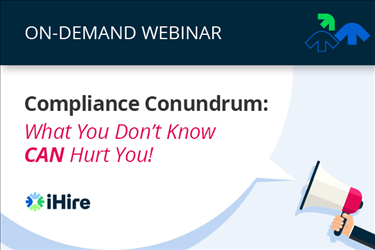- Employer Resources
- |
- Last Updated: October 06, 2021

Ways to Improve Disability Inclusion and Build a Comprehensive DEI Strategy
Disability inclusion is critical when developing a complete DEI strategy for your company. Raising awareness can help combat stigma, and improving employment practices will lend authenticity to your company’s message of inclusiveness. Celebrating National Disability Employment Awareness Month is one way to demonstrate your commitment to employees with disabilities. But that's just the tip of the iceberg. Below the surface, there's a lot more we can do.
The CDC estimates that 26% of adults in the U.S. live with at least one disability. That's one in four people, yet only around 28% of those with a college degree are currently employed. In any economy, especially in a time when employers find themselves struggling to fill positions, it's a colossal waste of talent.
Here are a few changes you can make to support current employees with disabilities and encourage more people with disabilities to join your team.
Recruit Employees with Disabilities to Grow Your Company Culture
If you’re not already, align recruiting objectives to hire for culture add vs. culture fit to strengthen your talent pool, boost innovation, and level up DEI initiatives. It will enable you to find better matches for your company and provide more meaningful job opportunities for this underrepresented community. An excellent first step is to make your recruitment process disability-friendly.
Start by evaluating current procedures to identify potential barriers. Call on staff who have self-identified as disabled, familiarize them with your process, and ask them to give you feedback. Let them review job postings and ask them to call out discriminatory or discouraging language (for example, unnecessary lifting requirements and minimum typing speeds).
Create partnerships with community-based groups to help remove unconscious or implicit bias from recruiting. They can provide you with training and new strategies to ensure people with disabilities feel included. Many of them can even help you source qualified candidates.
If possible, invite current employees with disabilities to join hiring panels. Job seekers will feel more confident in the team's ability to assess their skills without bias.
Finally, create questionnaires for applicants asking them to self-identify a disability. Then, give them a list of specific questions about their candidate experience. Let them know that your goal is to remove obstacles and provide a more equitable assessment for future job seekers.

Provide Reasonable Accommodation – and then Some
The Americans with Disabilities Act (ADA) prohibits discrimination and guarantees that people living with disabilities have equal opportunity to participate in every aspect of life, including employment. Employers must provide reasonable accommodation, but as a company that wants to lead the industry, why stop there?
Consider adjusting how you work. Conducting webinars with closed captioning for the hearing impaired or develop presentations for people with low visibility. Design company websites and other corporate communication channels so they follow WCAG guidelines for blind and low-vision users. Every company is unique, so start by asking employees what they need and build a plan around it.
Beyond changing how you work, provide employees with disabilities the tools they need to do their best work and excel within the company. To maximize the value and perspective that people with disabilities bring, you need representation in all roles, including top-level management. The best way to do that while building brand advocates is to have a solid growth plan.
Train Managers to Support Direct Reports with Disabilities
Employees feel valued when their managers invest in their success and well-being. Partner with diversity consultants and community organizations to train team leaders. Give them the tools they need to build trusted relationships. Encourage managers to find ways to help disabled employees achieve their goals and grow within the company. Provide the resources they need to deal with problems, such as intentional exclusion or discriminatory chatter.
The most critical component to the successful management of employees with disabilities is communication. Taking steps to train managers and leaders of all levels to support employees with disabilities will help build a culture of inclusiveness and maintain a positive work environment for everyone.
Create Your Account Today
Leverage Available Resources to Get a Head Start
Microsoft, Google, and other large companies partner with community-based organizations and consultants to improve disability inclusion. A simple internet search will turn up dozens of groups and professionals for your company to consider. Additionally, there are tons of free resources online. In fact, here's a list to get you started:
- Best Practices: Creating an Inclusive Workforce from the U.S. Department of Labor
- The Job Action Network (JAN) Workplace Accommodation Toolkit
- American Job Centers (free assistance with recruiting, hiring, or training employees)
Whether you’ve spent years developing company-wide goals for individuals with disabilities or you’re just getting started, one thing’s for sure: Improving disability inclusion is critical for a comprehensive DEI strategy. Having more people with disabilities on your team will add unique perspectives, increase innovation, and enhance the products and services you deliver to your clients.

Originally Published: October 06, 2021




